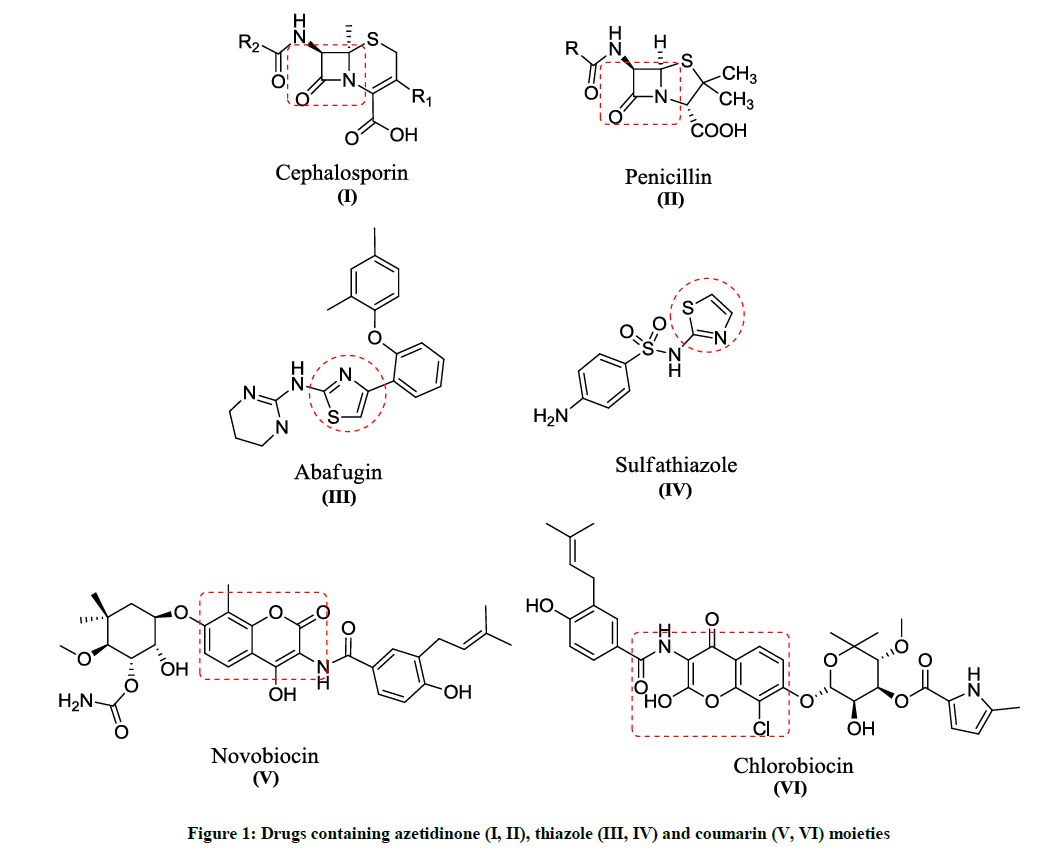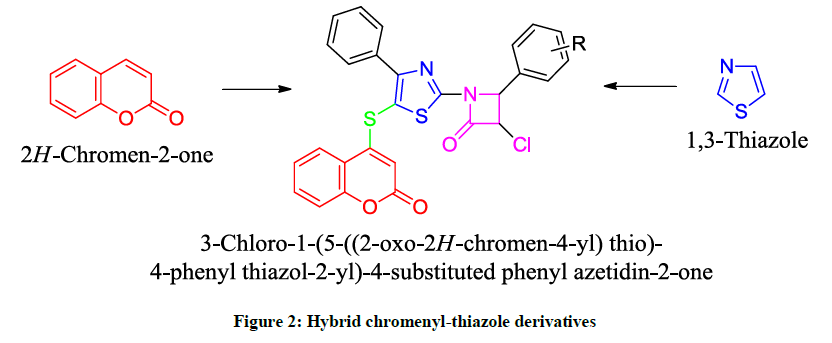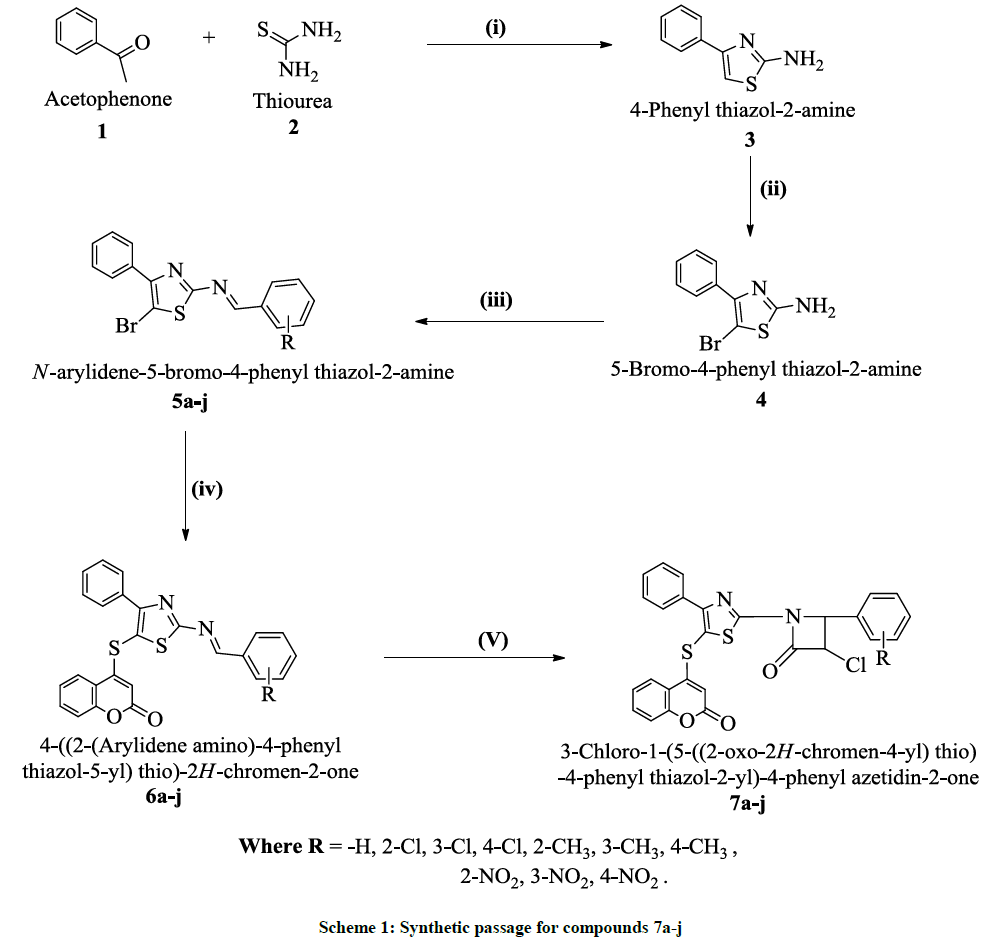Research Article - Der Pharma Chemica ( 2018) Volume 10, Issue 4
Design, Synthesis and In vitro Antimicrobial Screening of Some Novel Hybrid Coumarinyl-azetidinone Derivatives
Himanshu R Prajapati, Janki J Patel and Kishor H Chikhalia*
Department of Chemistry, School of Sciences, Gujarat University, Ahmedabad- 380009, Gujarat, India
- *Corresponding Author:
- Kishor H Chikhalia
Department of Chemistry
School of Sciences
Gujarat University
Ahmedabad- 380009, Gujarat, India
Abstract
In the present study, a series of novel 3-chloro-1-(5-((2-oxo-2H-chromen-4-yl)thio)-4-phenyl thiazol-2-yl)-4-substituted phenyl azetidin-2-ones (7a-j) have been efficiently synthesized in five steps by the use of acetophenone, thiourea, 4-mercapto coumarin and chloro-acetyl-chloride. The structures of all the newly synthesized analogues were characterized by 1H-NMR, 13C-NMR spectroscopy and mass analysis. All the final synthesized analogues were examined for their preliminary in vitro antibacterial activity against Gram-positive (Staphylococcus aureus and Streptococcus pyogenes) Gram-negative (Escherichia coli and Pseudomonas aeruginosa) bacteria and antifungal activity against (Candida albicans, Aspergillus niger and Aspergillus clavatus) strains by using broth dilution technique. The results of antimicrobial study revealed that some of the newly synthesized compounds exhibits potent activity against the present specific microbial strains.
Graphical Abstract
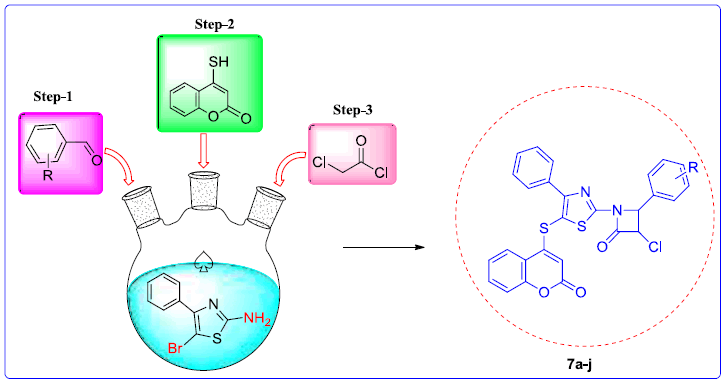
Keywords
Azetidin-2-one, Thioether bridge, Coumarin, Thiazole, Antibacterial activity, Antifungal activity
Introduction
From last centuries, many reports and patents have been published in which some of the research articles deal with pharmacological studies of several heterocyclic systems [1]. Drug resistance has become a growing medical problem in the treatment of infectious diseases caused by fungi and bacteria so, it is needed to discover some more effective antibiotics [2,3]. In medicinal chemistry, natural products are well-known due to their ability to react with other target compounds that represent a substantial source of inspiration for the design of structural analogues with improved pharmacological profile [4]. A major challenge of modern drug discovery is the design of highly efficient chemical reaction sequences by minimum number of synthetic steps to assemble compounds with interesting pharmacological properties [5].
Azetidinones are commonly known as β-lactam. They are part of antibiotics structure and show broad range of biological activities. A large number of 3-chloro monocyclic β-lactam exhibits potent antimicrobial, antibacterial, antitubercular, anti-inflammatory and anticonvulsant activities. Furthermore, they are also an effective on the central nervous system and also function as enzyme inhibitors. The chemistry of azetidinones (or β-lactams) are most important because β-lactam derivatives used as antibacterial agents [6]. Azetidinones have played an exclusive role in biological as well as medicinal chemistry. Their potent incongruous properties of pharmacological such as hypnotic antiflammatory, anti-convulsant and sedative. Generally, the β-lactam ring of azetidinones gets the antibiotic activity [7]. Azetidin-2-one scaffold is a well-known saturated form of azetidin. It is nitrogen based cyclobutane containing β-lactam ring organic compound. It is the carbonyl derivatives of azetidines containing carbonyl group at the position-2. 2-Azetidinones, are well-known heterocyclic compounds among organic and medicinal chemists. The activities of famous antibiotics such as aztreonam, carbapenems, cephalosporins, nocardicins, penicillins and thienamycin are attributed to the presence of a 2-azetidinone moiety in their structure [8]. In addition to these, the derivatives of azetidin-2- ones are potent comprehensive bioactive scaffolds due to their broad range of biological activities such as antibacterial [9,10], antitubercular [11- 14], antifungal [15,16], anticancer [17,18], antioxidant [19], anti-HIV [20], anti-inflammatory [21] etc.
The compounds of azoles and their derivatives have been broadly studied in medicinal chemistry several years due to their diverse biological activities such as antitumor, antifungal and antibacterial [22]. 1,3-Thiazoleis a heterocycle, an interesting bioactive scaffold in the synthetic as well as natural compounds. It possess potent antibacterial properties [23]. One of the most important azole compound is thiazole that contains five membered ring with nitrogen and sulfur atoms. Its skeleton has considered as versatile building block of the Vitamin B1 (Thiamine). Besides these, thiazole ring containing heterocycles exhibits with potent pharmaceutical activity in many drugs. i.e., Nizatidine, nitazoxanide, abafungin and sulfathiazole. among these abafungin used as an antifungal [24]. The compounds of substituted thiazole play vital role in nature and they possess a broad range of biological properties such as antioxidant [25], antimalarial [26], anti-protozoal [27], antitumor [28], antibacterial, antii-nflammatory [29], antiviral [30], antitubercular [31], antifungal [32], anti-cancer, anticonvulsants [33] etc.
Over the years, 2H-chromen-2-ones (or Coumarins, 2-oxo-2H-chromene,1-benzopyran-2-one) are naturally occurring oxygen-heterocyclic compounds. They are well-known form of lactones ring containing benzopyrone skeletal which are found extensively in nature [34,35]. The coumarin core is also present in various antibiotics such as coumermycin A1, chlorobiocin and novobiocin [36]. Numerous compounds of coumarin have showed great potency in the treatment of several types of diseases. Derivatives of coumarin possess versatile biological activities such as antifungal, anti-tubercular, antioxidant, antibacterial, anticancer, anti-inflammatory, antiviral, anticoagulant and anti-malarial properties [37]. As is well known cephalosporin, penicillin, abafugin, sulfathiazole, chlorobiocin and novobiocin are all based on the keywords (Figure 1).
In the present article, we have described the design and synthesis of a new series of azetidin-2-one heterocycle derivatives by the combination of different pharmacophores i.e., thiazole and coumarin (Figure 2). In the structure of azetidin-2-one, both different pharmacophores such as thiazole and coumarin merged by thio(sulphur, -S-) bridge. These both pharmacophores (Thiazole, coumarin) rises antimicrobial activity. As a result, thiazole and coumarin comprising azetidin-2-one moiety is expected to have enhanced antimicrobial activities. Thus, these observations encouraged us to synthesize new azetidin-2-one derivatives.
Material and Methods
All the chemicals and solvents used for the synthesis work acquired from commercial sources, were of analytical grade, and used without further purification. Melting points were determined by using open capillary tubes and are uncorrected. TLC was checked on E-Merck pre-coated 60 F254 plates and the spots were rendered visible by exposing to UV light or iodine. NMR spectra were recorded on 400 MHz Bruker Avance instrument using TMS as internal standard (Chemical Shift in δ, ppm) and DMSO-d6 as a solvent. Spectra were taken with a resonant frequency of 400 MHz for 1H-NMR and 100 MHz for 13C-NMR. The splitting patterns are designated as follows; s, singlet; d, doublet; dd, doublet of doublets; t, triplet and m, multiplet. Elemental analysis was done on “Haraeus Rapid Analyser”. The mass spectra were recorded on JOEL SX- 102 (EI) model with 60 eV ionizing energy.
Synthesis of 4-phenyl thiazol-2-amine, 3
The mixture of thiourea (12.61 g, 0.166 mol) and iodine (10.41 g, 0.041 mol) were added to a stirring solution of the acetophenone (10 g, 0.083 mol) in absolute ethanol (50 ml). The mixture was heated at 80°C for 2-3 h. Progress of the reaction was monitored by TLC using ethyl acetate: hexane (2:8) as eluent. After the completion of reaction, the pH of the solution was adjusted to 7.0 by drop wise addition of NH4OH solution. The crude generated was filtered and extracted with ether (4 × 10 ml). It was then recrystallized from hot water to get the title compound. Yield: 85%.
Synthesis of 5-bromo-4-phenyl thiazol-2-amine, 4
To an ice-cold solution of 4-phenylthiazol-2-amine (7.0 g, 0.040 mol) in glacial acetic acid (30 ml), a solution of bromine (5.0 ml, 0.039 mol) in acetic acid (10 ml) was added drop wise at 5-10°C during 30 min. The mixture was further stirred at room temperature for 2 h. Progress of the reaction was monitored by TLC using ethyl acetate: hexane (2:8) as eluent. After the completion of reaction it was dumped in to water. The precipitated solid was collected by filtration, washed with ice-cold acetic acid (5.0 ml) and water, neutralized by NH4OH solution and recrystallized from aqueous ethanol to get a brown solid product. Yield: 80%.
General procedure for the synthesis of N-arylidene-5-bromo-4-phenyl thiazol-2-amine, 5a-j
A mixture of 5-bromo-4-phenyl thiazol-2-amine (3.5 g, 0.01 mol), benzaldehyde (0.01 mol, 1.06 ml) in ethanol (15 ml), and acetic acid (0.5 ml) was refluxed for 6 h. Progress of the reaction was monitored by TLC using ethyl acetate: hexane (1:9) as eluent. The solvent was removed and the residue was added to crushed ice. The solid precipitates obtained were collected by filtration and purified by recrystallization from ethanol to get pale yellow solid product. Yield: 78%.
General procedure for synthesis of 4-((2-(arylidene amino)-4-phenyl thiazol-5-yl)thio)-2H-chromen-2-one, 6a-j
Alcoholic solution of 4-mercapto-2H-chromen-2-one (3.4 g, 0.019 mol) was added to the solution of N-arylidene-5-bromo-4-phenyl thiazol-2- amine (5 g, 0.019 mol) in alcohol. The mixture was then refluxed on a steam bath for 5 h. Progress of the reaction was monitored by TLC using ethyl acetate: hexane (1:9) as eluent. After the completion of reaction, the residue was poured into crushed ice to give a solid. The separated solid was filtered off and recrystallized from methanol to get the title compound. Yield: 75%.
General procedure for the synthesis of compounds, 7a-j
To a mixture of 4-((2-(arylidene amino)-4-phenyl thiazol-5-yl) thio)-2H-chromen-2-one (0.0045 mol) in 1, 4 dioxane (10 ml) chloro-acetyl-chloride (0.5 g (0.35 ml), 0.0045 mol) and triethyl-amine (0.63 ml, 0.0045 mol) was added at 0-5°C and stirred for 40 min at room temperature. The temperature of the reaction mixture was gradually raised and refluxed for 7 h. Progress of the reaction was monitored by TLC using ethyl acetate: hexane (2:8) as eluent. After the completion of reaction, the excess solvent was removed in vacuum, and the left solid was treated with crushed ice to afford a solid product. The solid obtained was filtered, washed with water, pH was adjusted to neutrality and recrystallized from absolute alcohol, to get the title compound. Yield: 72% (Table 1).
| Compound | -R | Molecular formula | M.P °C | Yield % |
Elemental Analysis | |||
|---|---|---|---|---|---|---|---|---|
| %C | %H | %N | ||||||
| 7a | -H | C27H17ClN2O3S2 | 290 | 76 | R F |
62.72 62.77 |
3.31 3.35 |
5.42 5.46 |
| 7b | 2-Cl | C27H16Cl2N2O3S2 | 299 | 72 | R F |
58.81 58.86 |
2.92 2.97 |
5.08 5.13 |
| 7c | 3-Cl | C27H16Cl2N2O3S2 | 289 | 70 | R F |
58.81 58.77 |
2.92 2.88 |
5.08 5.03 |
| 7d | 4-Cl | C27H16Cl2N2O3S2 | 296 | 72 | R F |
58.81 58.83 |
2.92 2.90 |
5.08 5.11 |
| 7e | 2-CH3 | C28H19ClN2O3S2 | 295 | 73 | R F |
63.33 63.38 |
3.61 3.66 |
5.28 5.33 |
| 7f | 3-CH3 | C28H19ClN2O3S2 | 292 | 78 | R F |
63.33 63.30 |
3.61 3.56 |
5.28 5.25 |
| 7g | 4-CH3 | C28H19ClN2O3S2 | 276 | 70 | R F |
63.33 63.35 |
3.61 3.63 |
5.28 5.30 |
| 7h | 2-NO2 | C27H16ClN3O5S2 | 277 | 73 | R F |
57.70 57.75 |
2.87 2.92 |
7.48 7.53 |
| 7i | 3-NO2 | C27H16ClN3O5S2 | 290 | 75 | R F |
57.70 57.66 |
2.87 2.82 |
7.48 7.43 |
| 7j | 4-NO2 | C27H16ClN3O5S2 | 288 | 77 | R F |
57.70 57.72 |
2.87 2.90 |
7.48 7.51 |
Table 1: Physical constant of newly synthesized compounds 7a-j
Chemistry
Characterisation of products
3-Chloro-1-(5-((2-oxo-2H-chromen-4-yl)thio)-4-phenyl thiazol-2-yl)-4-phenylazetidin-2-one (7a):
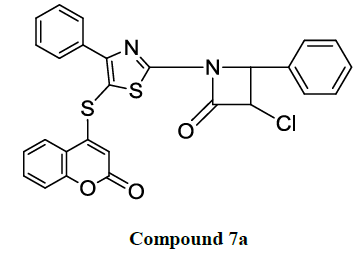
White solid, Yield 76%; m.p. 290°C; 1H-NMR (400 MHz, DMSO-d6) δppm: 5.324 (d, J=5.4 Hz, 1H, azetidinone), 5.860 (d, J=6.0 Hz, 1H, azetidinone), 6.232 (s, 1H, coumarin) and 7.200-7.809 (m, 14H, aromatic ring); 13C-NMR (100 MHz, DMSO-d6) δppm: 61.26, 64.12, 118.09, 119.42, 121.06, 125.30, 127.61, 128.97, 129.08, 129.16, 129.20, 129.27, 129.89, 130.92, 133.75, 134.21, 135.53, 151.69, 157.05, 157.67, 158.28, 163.63, 164.79. Anal. calcd. For C27H17ClN2O3S2: C, 62.72; H, 3.31; N, 5.42. Found: C, 62.77; H, 3.55; N, 5.46. ESIMS (m/z): 518.02 (M+).
3-Chloro-4-(2-chlorophenyl)-1-(5-((2-oxo-2H-chromen-4-yl)thio)-4-phenylthiazol-2-yl)azetidin-2-one (7b):
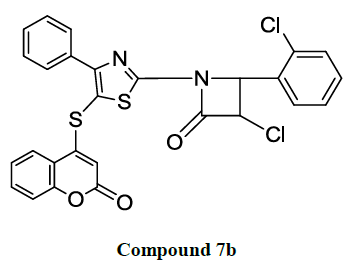
White solid, Yield 72%; m.p. 299°C; 1H-NMR (400 MHz, DMSO-d6) δppm: 5.440 (d, J=5.8 Hz, 1H, azetidinone), 6.391 (d, J=6.4 Hz, 1H, azetidinone), 6.452 (s, 1H, coumarin) and 7.167-7.654 (m, 13H, aromatic ring); 13C-NMR (100 MHz, DMSO-d6) δppm: 60.87, 64.30, 118.09, 119.42, 121.06, 125.30, 126.88, 127.61, 128.09, 129.08, 129.16, 129.27, 129.56, 129.89, 132.61, 133.75, 134.21, 134.99, 139.38, 151.69, 157.05, 157.67, 158.28, 163.63, 164.79. Anal. calcd. For C27H16Cl2N2O3S2: C, 58.81; H, 2.92; N, 5.08. Found: C, 58.86; H, 2.97; N, 5.13. ESIMS (m/z): 552.47 (M+).
3-Chloro-4-(3-chlorophenyl)-1-(5-((2-oxo-2H-chromen-4-yl)thio)-4-phenylthiazol-2-yl)azetidin-2-one (7c):
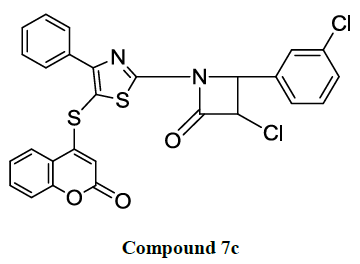
White solid, Yield 70%; m.p. 289°C; 1H-NMR (400 MHz, DMSO-d6) δppm: 5.403 (d, J=6.4 Hz, 1H, azetidinone), 5.966 (d, J=6.0 Hz, 1H, azetidinone), 6.157 (s, 1H, coumarin) and 7.203-7.888 (m, 13H, aromatic ring); 13C-NMR (100 MHz, DMSO-d6) δppm: 61.23, 65.80, 70.12, 116.67, 121.07, 123.22, 126.76, 127.51, 128.94, 129.08, 129.16, 129.27, 129.30, 129.89, 130.95, 131.41, 132.05, 134.20, 134.32, 134.82, 138.48, 156.04, 157.05, 158.28, 163.63. Anal. calcd. For C27H16Cl2N2O3S2: C, 58.81; H, 2.92; N, 5.08. Found: C, 58.77; H, 2.88; N, 5.03. ESIMS (m/z): 552.47 (M+).
3-Chloro-4-(4-chlorophenyl)-1-(5-((2-oxo-2H-chromen-4-yl)thio)-4-phenylthiazol-2-yl)azetidin-2-one (7d):
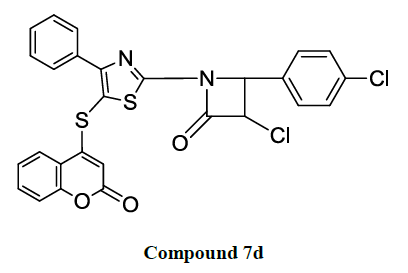
White solid, Yield 72%; m.p. 296°C; 1H-NMR (400 MHz, DMSO-d6) δppm: 5.440 (d, J=6.2 Hz, 1H, azetidinone), 5.934 (d, J=6.6 Hz, 1H, azetidinone), 6.171 (s, 1H, coumarin) and 7.211-7.785 (m, 13H, Aromatic ring); 13C-NMR (100 MHz, DMSO-d6) δppm: 61.23, 65.19, 118.09, 119.42, 121.06, 125.30, 127.61, 128.84, 129.08, 129.16, 129.27, 129.89, 132.39, 133.75, 134.16, 134.21, 135.00, 151.69, 157.05, 157.67, 158.28, 163.63, 164.79. Anal. calcd. For C27H16Cl2N2O3S2: C, 58.81; H, 2.92; N, 5.08. Found: C, 58.83; H, 2.90; N, 5.11. ESIMS (m/z): 552.47 (M+).
3-Chloro-1-(5-((2-oxo-2H-chromen-4-yl)thio)-4-phenylthiazol-2-yl-4-(o-tolyl)azetidin-2-one (7e):
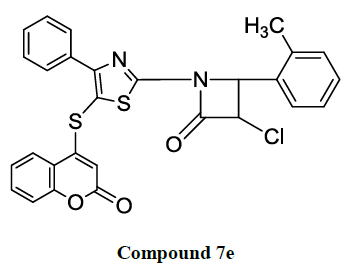
White solid, Yield 73%; m.p. 295°C; 1H-NMR (400 MHz, DMSO-d6) δppm: 2.391 (s, 3H, methyl), 5.400 (d, J=5.4 Hz, 1H, azetidinone), 5.989 (d, J=6.0 Hz, 1H, azetidinone), 6.164 (s, 1H, coumarin) and 7.167-7.784 (m, 13H, aromatic ring); 13C-NMR (100 MHz, DMSO-d6) δppm: 19.27, 60.87, 65.07, 118.09, 119.42, 121.06, 125.30, 127.09, 127.61, 128.71, 129.08, 129.16, 129.27, 129.59, 129.89, 131.84, 133.75, 134.21, 134.47, 140.74, 151.69, 157.05, 157.67, 158.28, 163.63, 164.79. Anal. calcd. For C28H19ClN2O3S2: C, 63.33; H, 3.61; N, 5.28. Found: C, 63.38; H, 3.66; N, 5.33. ESIMS (m/z): 532.06 (M+).
3-Chloro-1-(5-((2-oxo-2H-chromen-4-yl)thio)-4-phenylthiazol-2-yl-4-(m-tolyl)azetidin-2-one (7f)
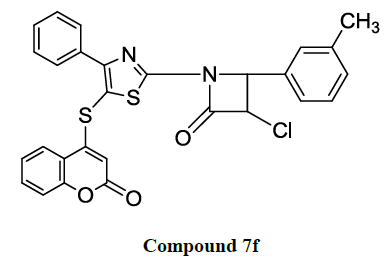
White solid, Yield 78%; m.p. 292°C; 1H-NMR (400 MHz, DMSO-d6) δppm: 2.310 (s, 3H, methyl), 5.440 (d, J=5.4 Hz, 1H, azetidinone), 5.977 (d, J=5.6 Hz, 1H, azetidinone), 6.172 (s, 1H, coumarin) and 7.088-7.786 (m, 13H, aromatic ring); 13C-NMR (100 MHz, DMSO-d6) δppm: 21.20, 61.20, 65.85, 118.09, 119.42, 121.06, 125.30, 127.61, 128.26, 128.30, 129.03, 129.08, 129.16, 129.27, 129.89, 130.52, 133.75, 134.21, 134.27, 139.21, 151.69, 157.05, 157.67, 158.28, 163.63, 164.79. Anal. calcd. For C28H19ClN2O3S2: C, 63.33; H, 3.56; N, 5.28. Found: C, 63.30; H, 3.55; N, 5.25. ESIMS (m/z): 532.06 (M+).
3-Chloro-1-(5-((2-oxo-2H-chromen-4-yl)thio)-4-phenylthiazol-2-yl)-4-(p-tolyl)azetidin-2-one (7g):
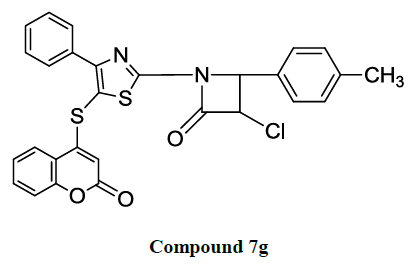
White solid, Yield 70%; m.p. 276°C; 1H-NMR (400 MHz, DMSO-d6) δppm: 2.306 (s, 3H, methyl), 5.320 (d, J=5.8 Hz, 1H, azetidinone), 5.929 (d, J=5.8 Hz, 1H, azetidinone), 6.172 (s, 1H, coumarin) and 7.064-7.813 (m, 13H, aromatic ring). 13C-NMR (100 MHz, DMSO-d6) δppm: 21.12, 61.23, 65.19, 118.09, 119.42, 121.06, 125.30, 127.61, 129.08, 129.16, 129.27, 129.89, 130.44, 131.09, 133.75, 134.21, 134.24, 135.91, 151.69, 157.05, 157.67, 158.28, 163.63, 164.79. Anal. calcd. For C28H19ClN2O3S2: C, 63.33; H, 3.61; N, 5.28. Found: C, 63.35; H, 3.63; N, 5.30. ESIMS (m/z): 532.06 (M+).
3-Chloro-4-(2-nitrophenyl)-1-(5-((2-oxo-2H-chromen-4-yl)thio)-4-phenylthiazol-2-yl)azetidin-2-one (7h)
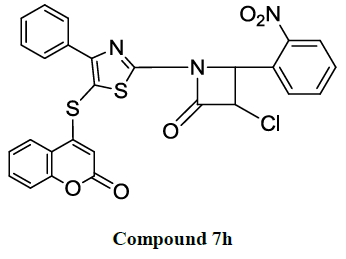
Yellow solid, Yield 73%; m.p. 277°C; 1H-NMR (400 MHz, DMSO-d6) δppm: 5.421 (d, J=5.6 Hz, 1H, azetidinone), 5.996 (d, J=5.0 Hz, 1H, azetidinone), 6.153 (s, 1H, coumarin) and 7.213-8.313 (m, 13H, aromatic ring). 13C-NMR (100 MHz, DMSO-d6) δppm: 60.87, 64.63, 118.09, 119.42, 121.06, 125.30, 125.56, 127.61, 127.69, 129.08, 129.16, 129.17, 129.27, 129.89, 133.75, 134.21, 135.76, 136.23, 151.69, 155.06, 157.05, 157.67, 158.28, 163.63, 164.79. Anal. calcd. For C27H16ClN3O5S2: C, 57.70; H, 2.87; N, 7.48. Found: C, 57.75; H, 2.92; N, 7.53. ESIMS (m/z): 563.03 (M+).
3-Chloro-4-(3-nitrophenyl)-1-(5-((2-oxo-2H-chromen-4-yl)thio)-4-phenylthiazol-2-yl)azetidin-2-one (7i):
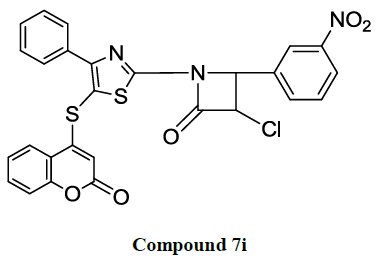
Light Yellow solid, Yield 75%; m.p. 290°C; 1H-NMR (400 MHz, DMSO-d6) δppm: 5.440 (d, J=5.2 Hz, 1H, azetidinone), 6.023 (d, J=6.0 Hz, 1H, azetidinone), 6.170 (s, 1H, coumarin) and 7.214-8.338 (m, 13H, aromatic ring); 13C-NMR (100 MHz, DMSO-d6) δppm: 61.23, 65.85, 118.09 119.42, 121.06, 124.20, 125.30, 126.69, 127.61, 129.08, 129.16, 129.27, 129.89, 130.70, 133.75, 134.21, 135.63, 136.47, 149.22, 151.69, 157.05, 157.67, 158.28, 163.63, 164.79. Anal. calcd. For C27H16ClN3O5S2: C, 57.70; H, 2.87; N, 7.48. Found: C, 57.66; H, 2.82; N, 7.43. ESIMS (m/z): 563.03 (M+).
3-Chloro-4-(4-nitrophenyl)-1-(5-((2-oxo-2H-chromen-4-yl)thio)-4-phenylthiazol-2-yl)azetidin-2-one (7j)
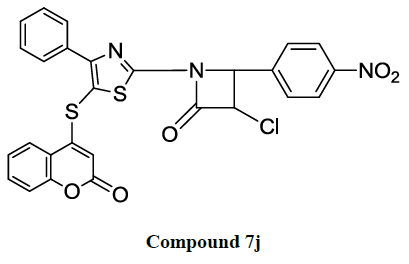
Pale Yellow solid, Yield 77%; m.p. 288°C; 1H-NMR (400 MHz, DMSO-d6) δppm: 5.402 (d, J=5.8 Hz, 1H, azetidinone), 6.038 (d, J=6.2 Hz, 1H, azetidinone), 6.183 (s, 1H, coumarin) and 7.213-8.232 (m, 13H, aromatic ring); 13C-NMR (100 MHz, DMSO-d6) δppm: 61.23, 65.19, 118.09, 119.42, 121.06, 124.51, 125.30, 127.61, 129.08, 129.16, 129.27, 129.89, 131.04, 133.75, 134.21, 143.12, 143.44, 151.69, 157.05, 157.67, 158.28, 163.63, 164.79. Anal. calcd. For C27H16ClN3O5S2: C, 57.70; H, 2.87; N, 7.48. Found: C, 57.72; H, 2.90; N, 7.51. ESIMS (m/z): 518.02 (M+) (Scheme 1).
1H-NMR and 13C-NMR Spectra’s:
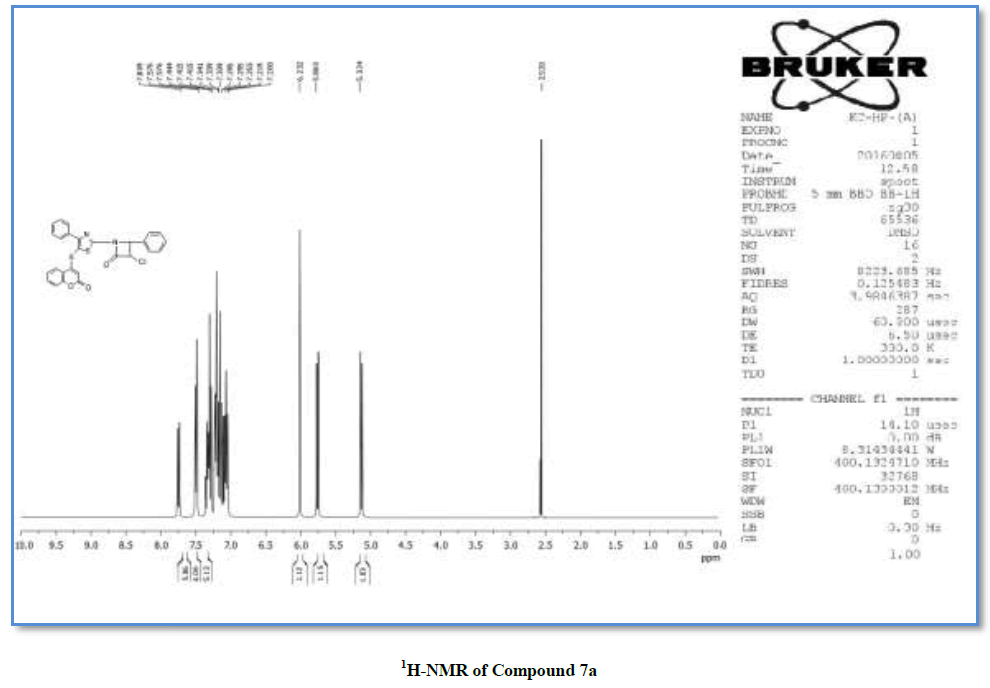
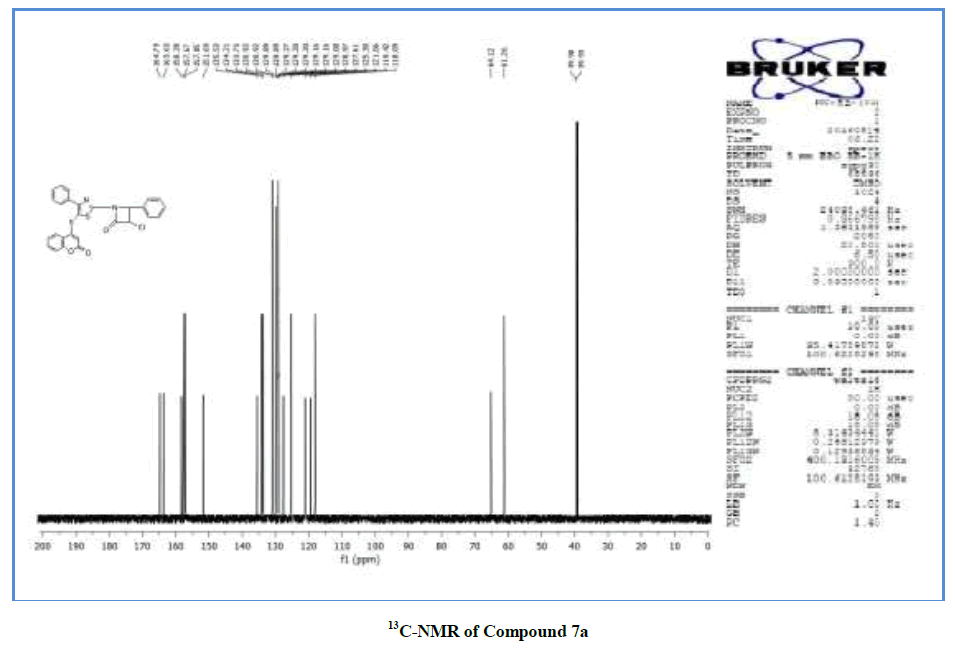
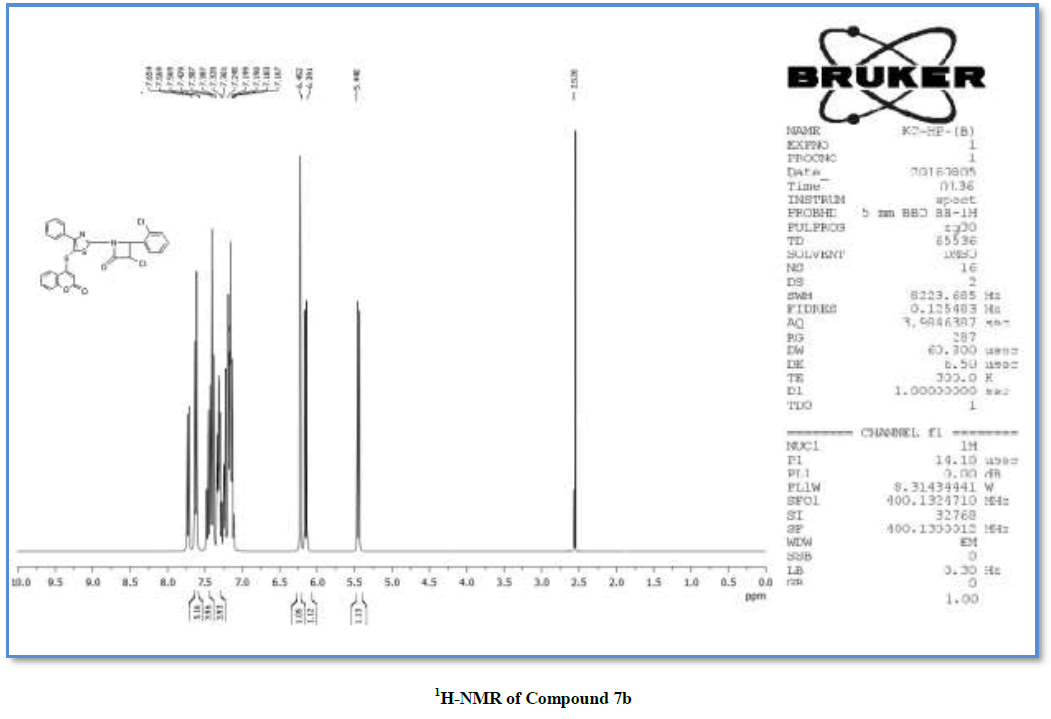
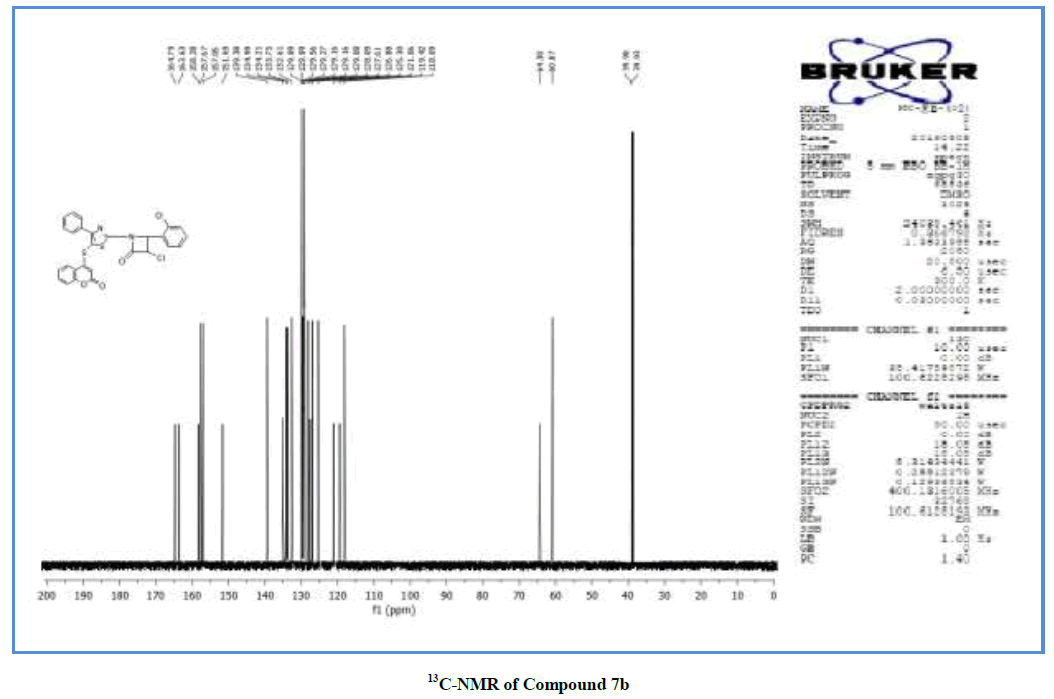
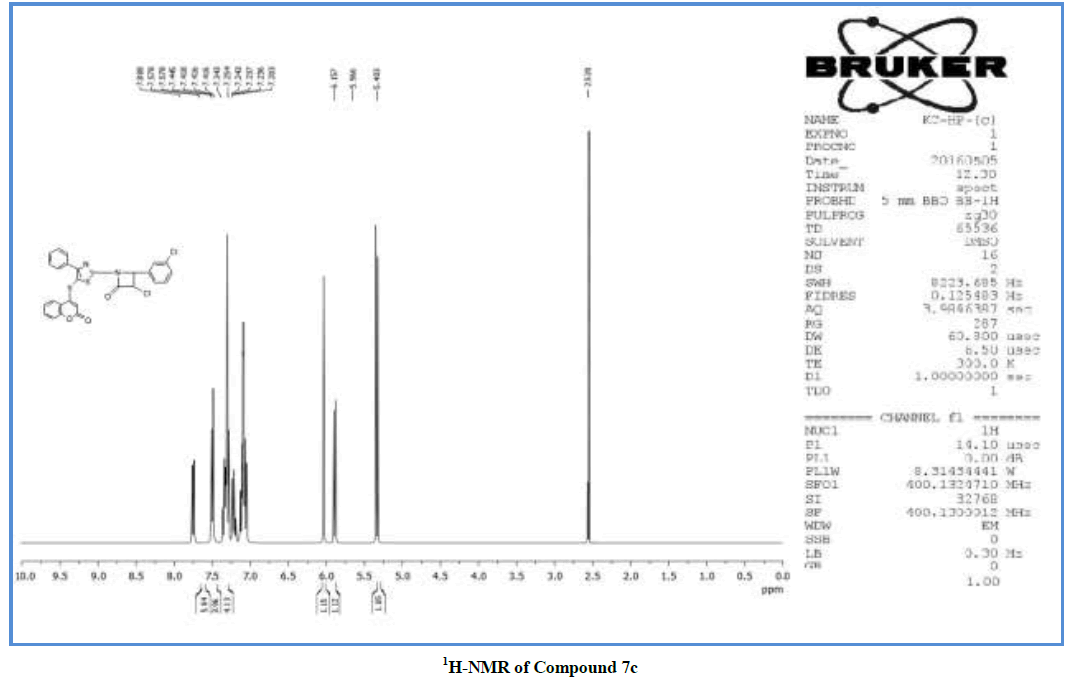
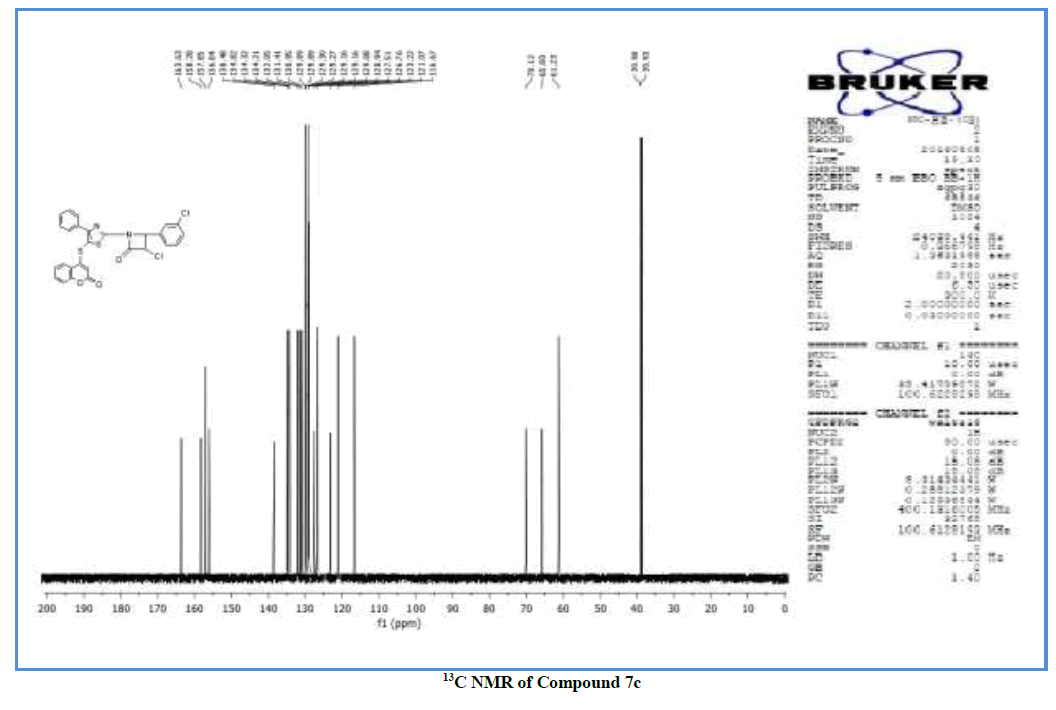
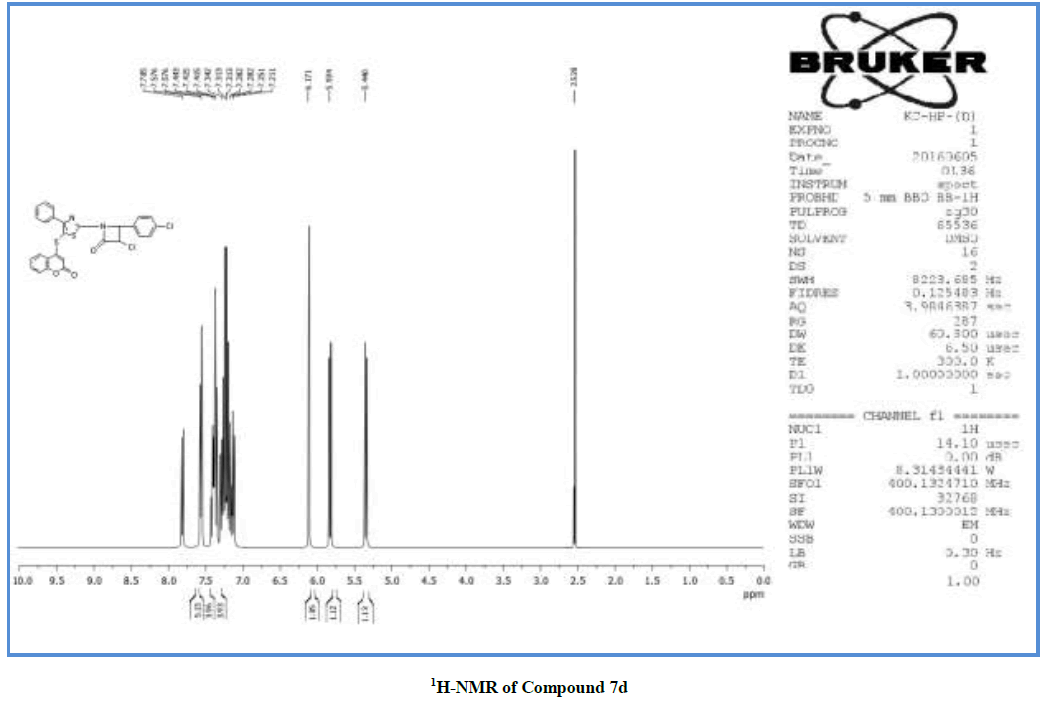
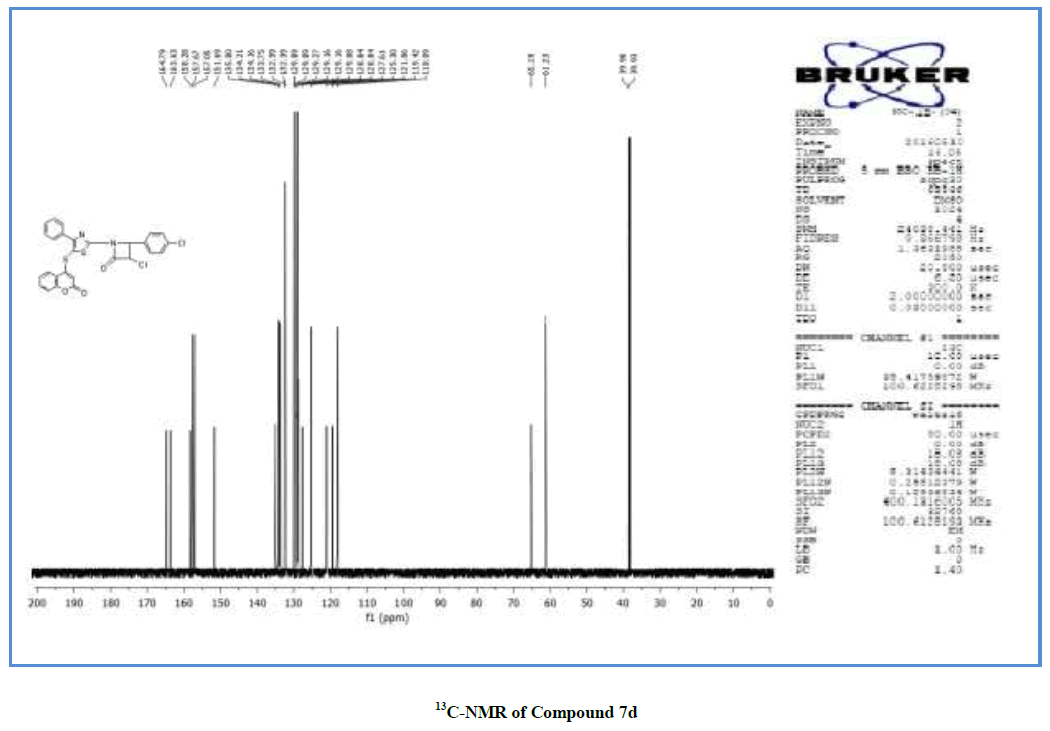
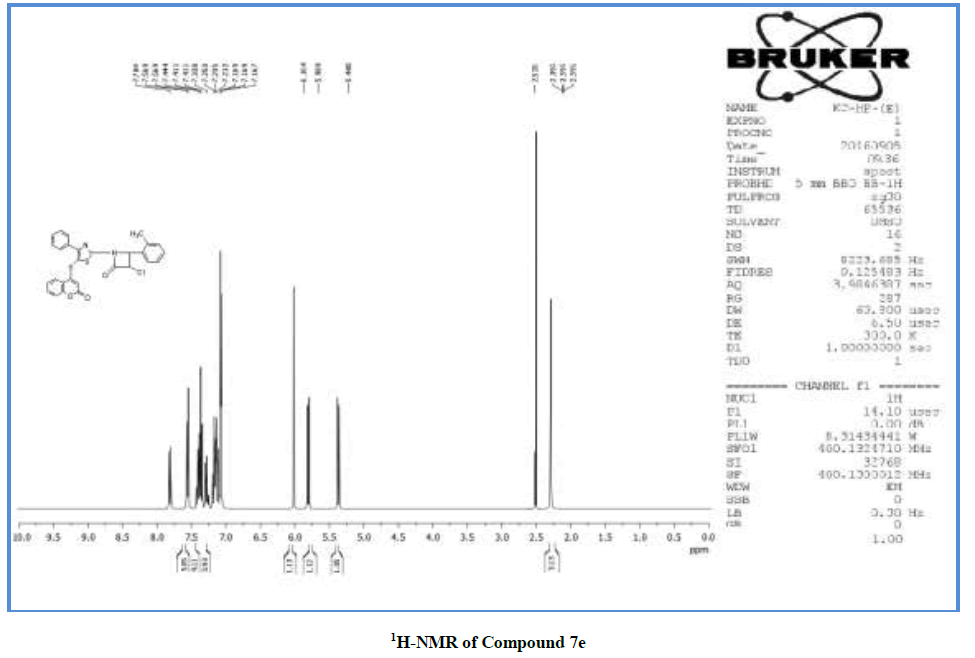
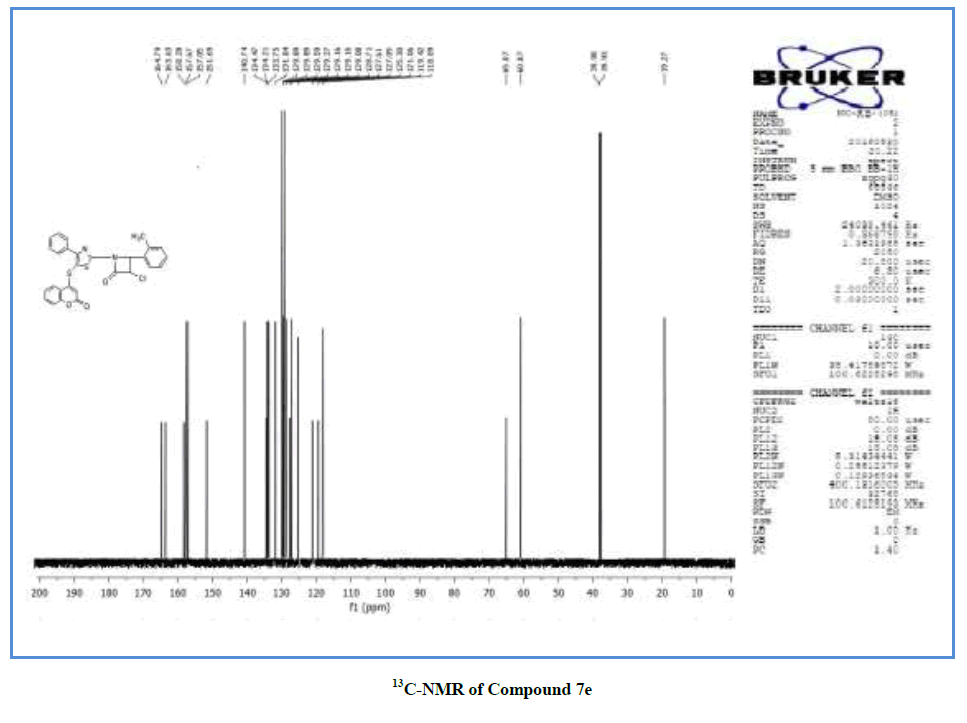
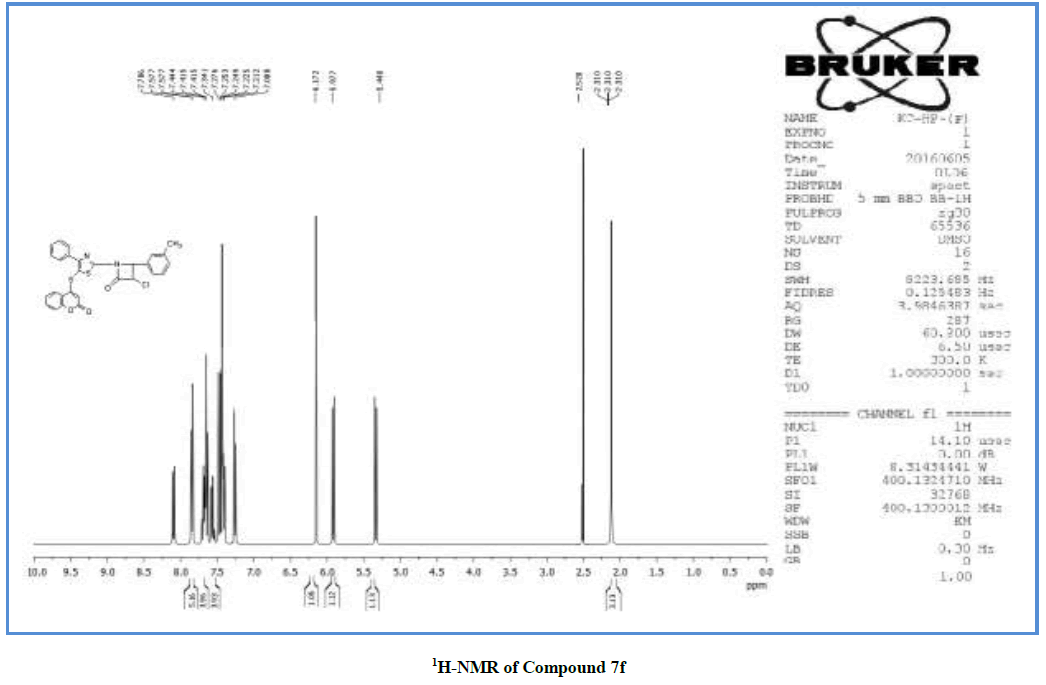
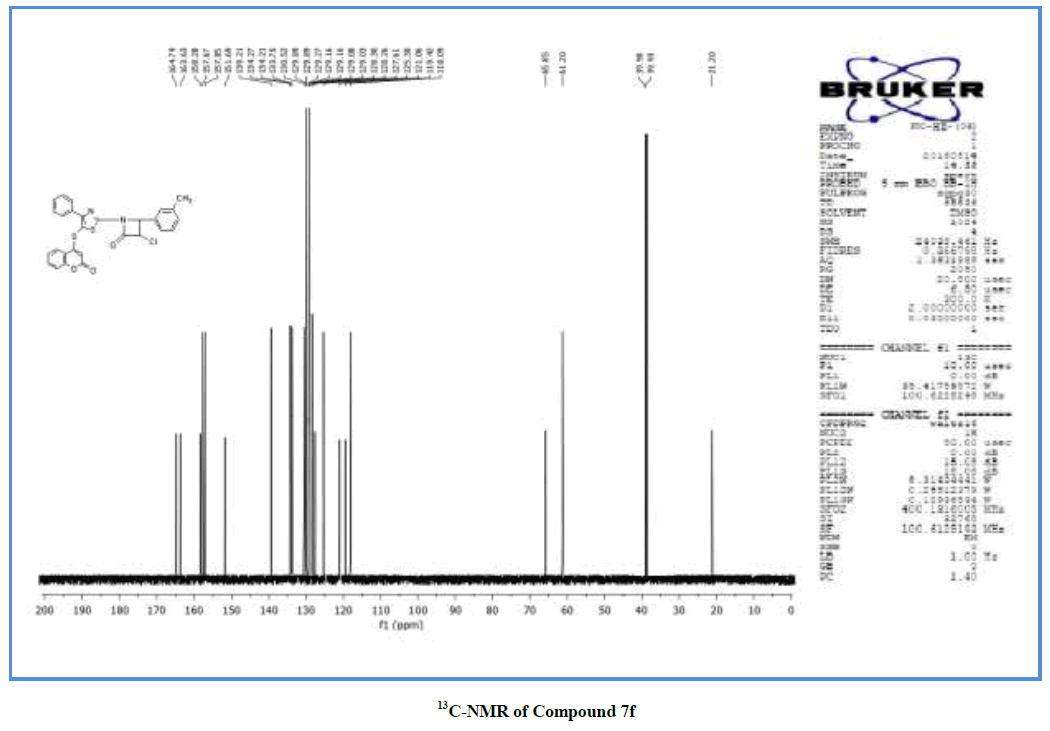
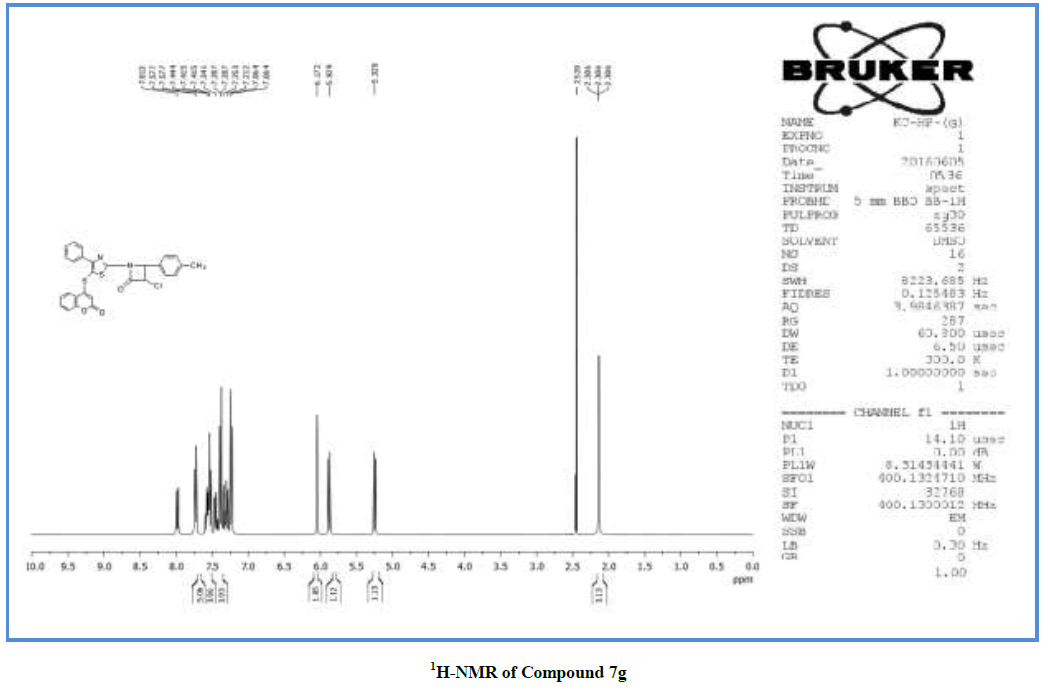
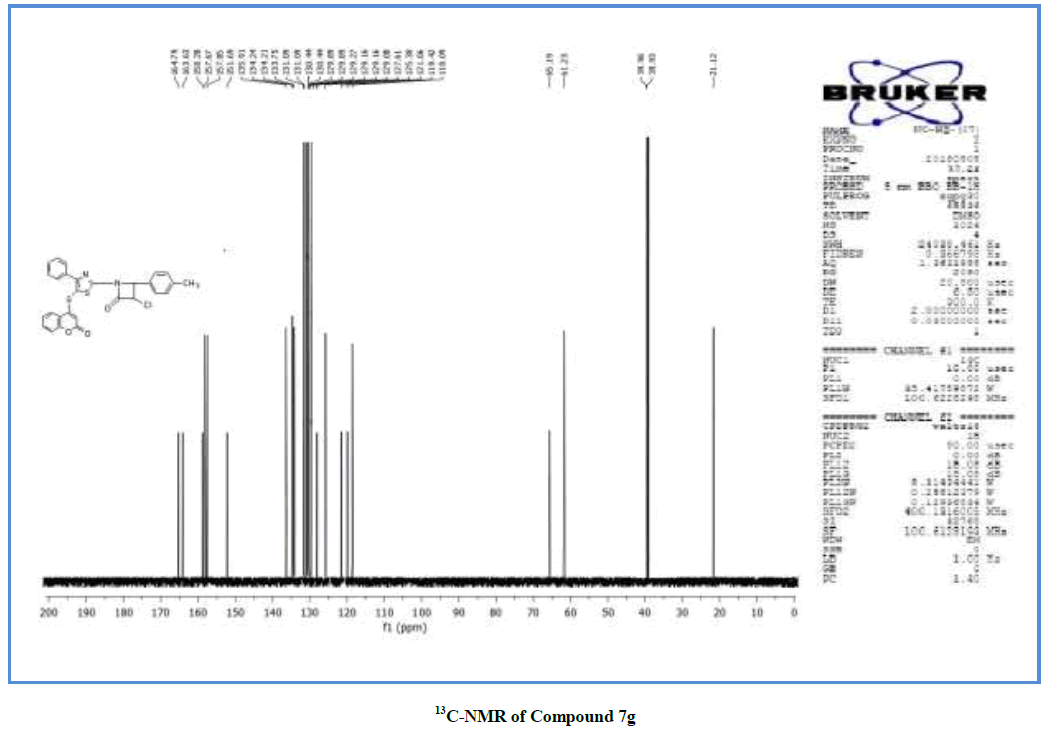
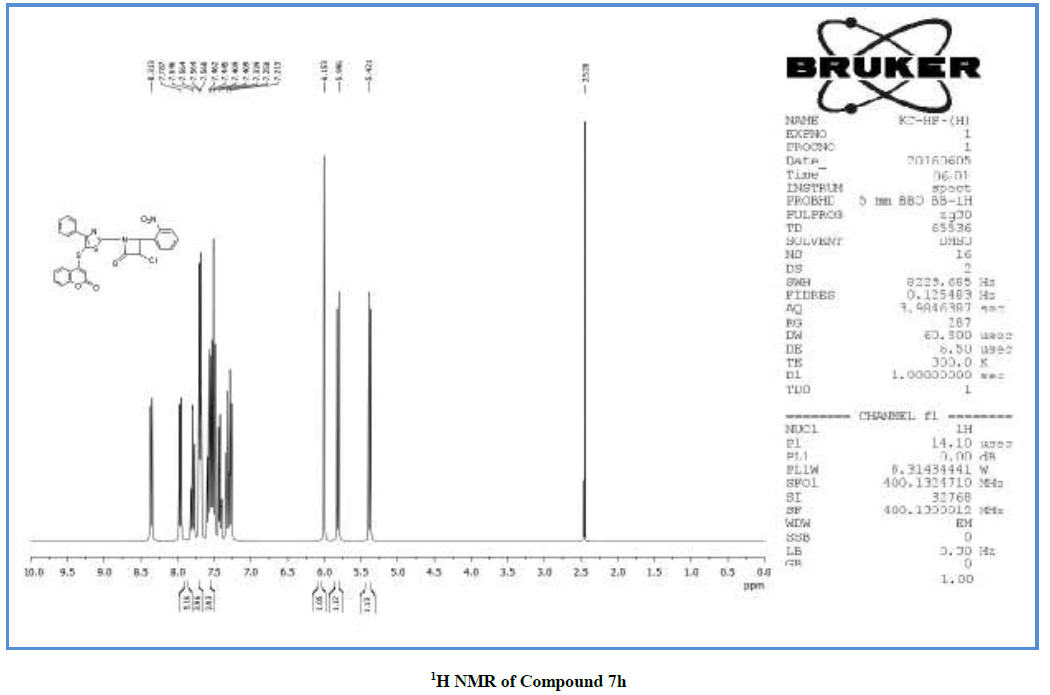
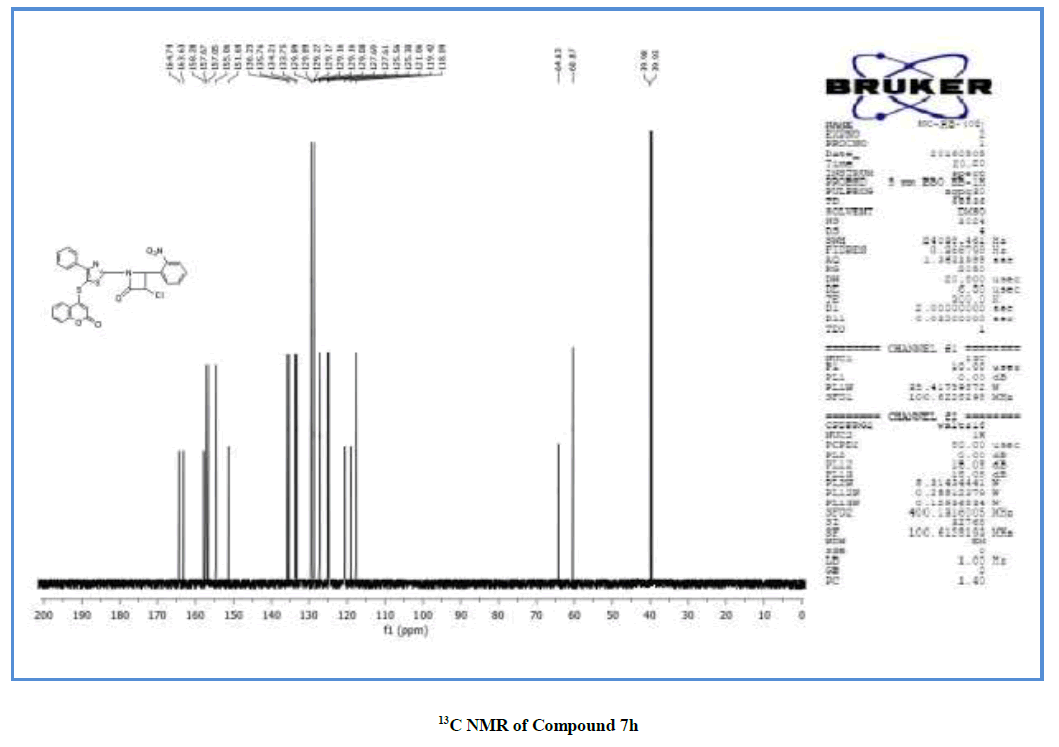
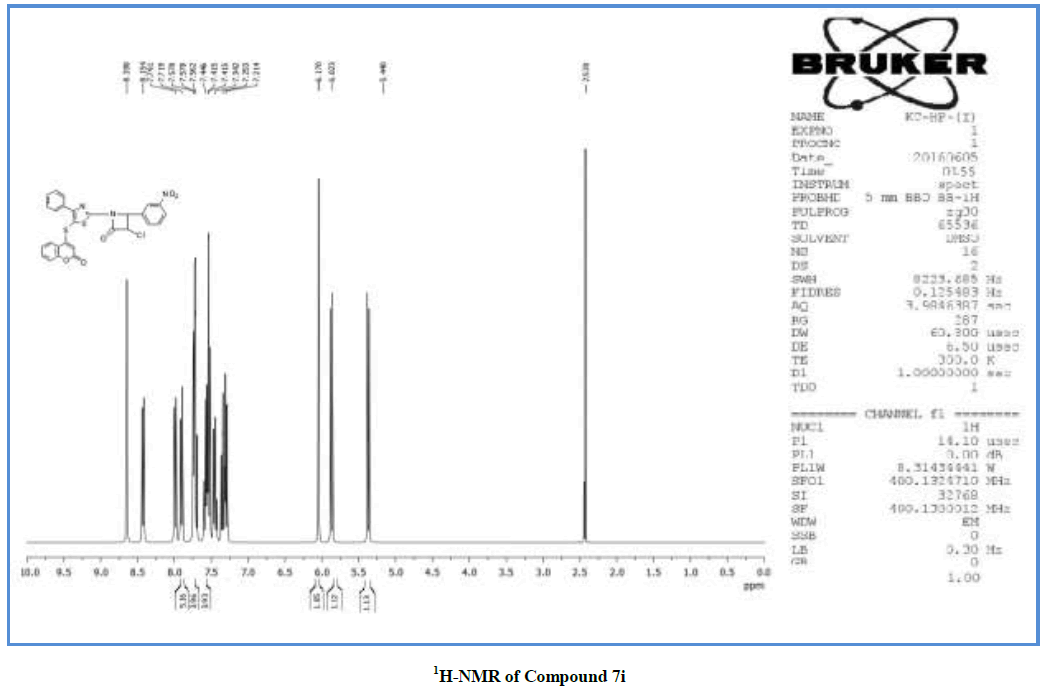
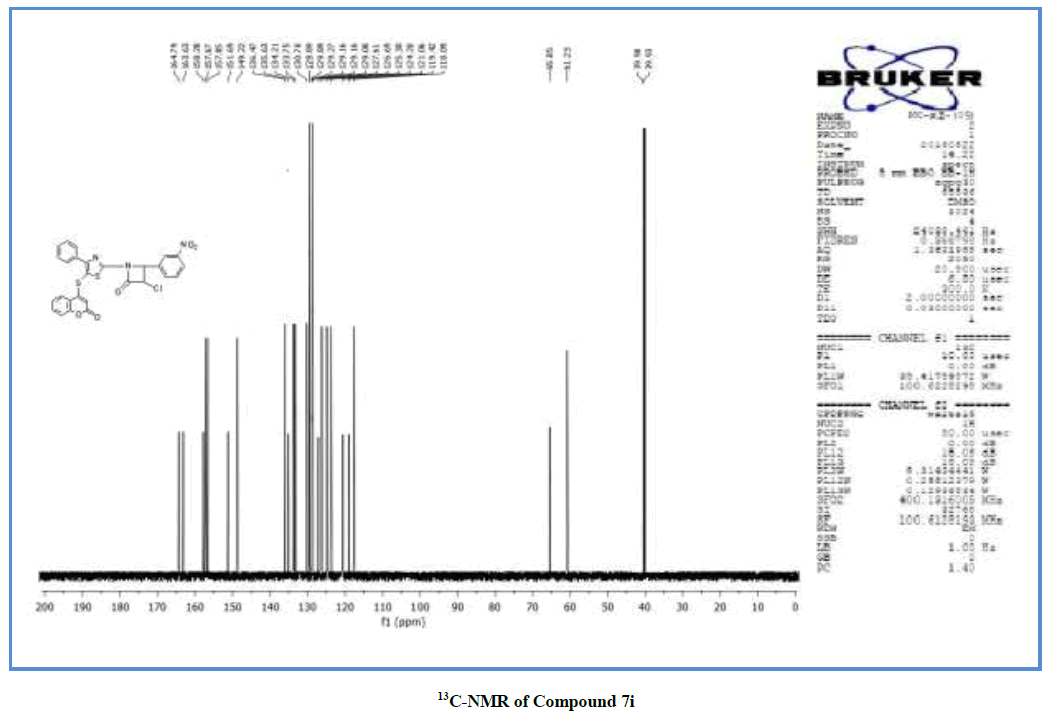
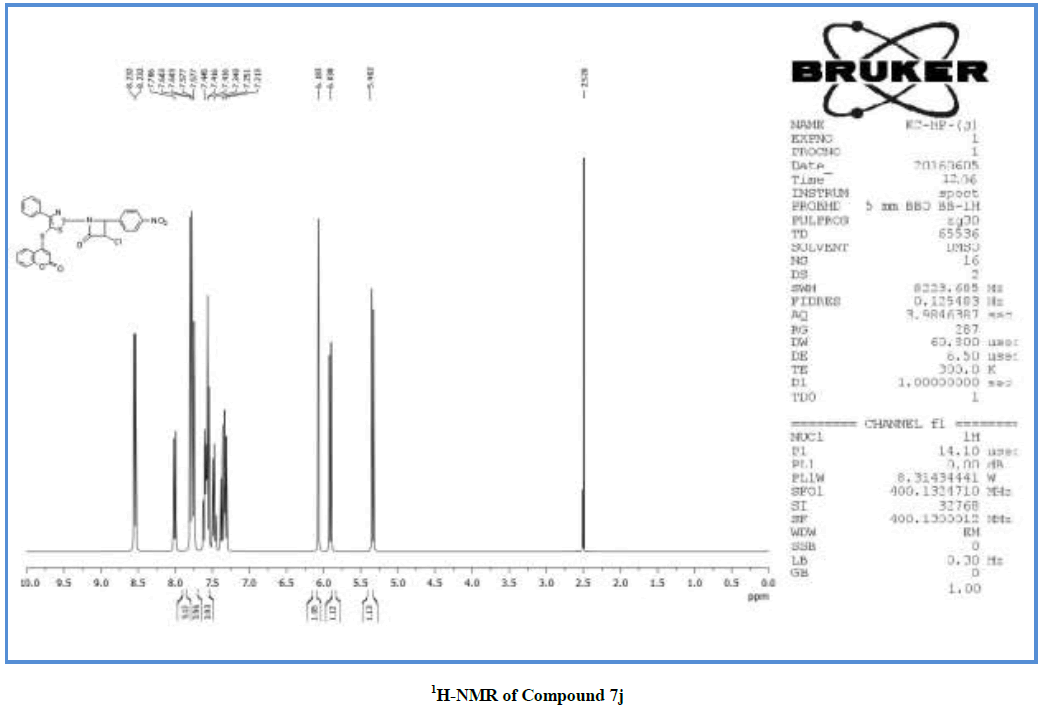
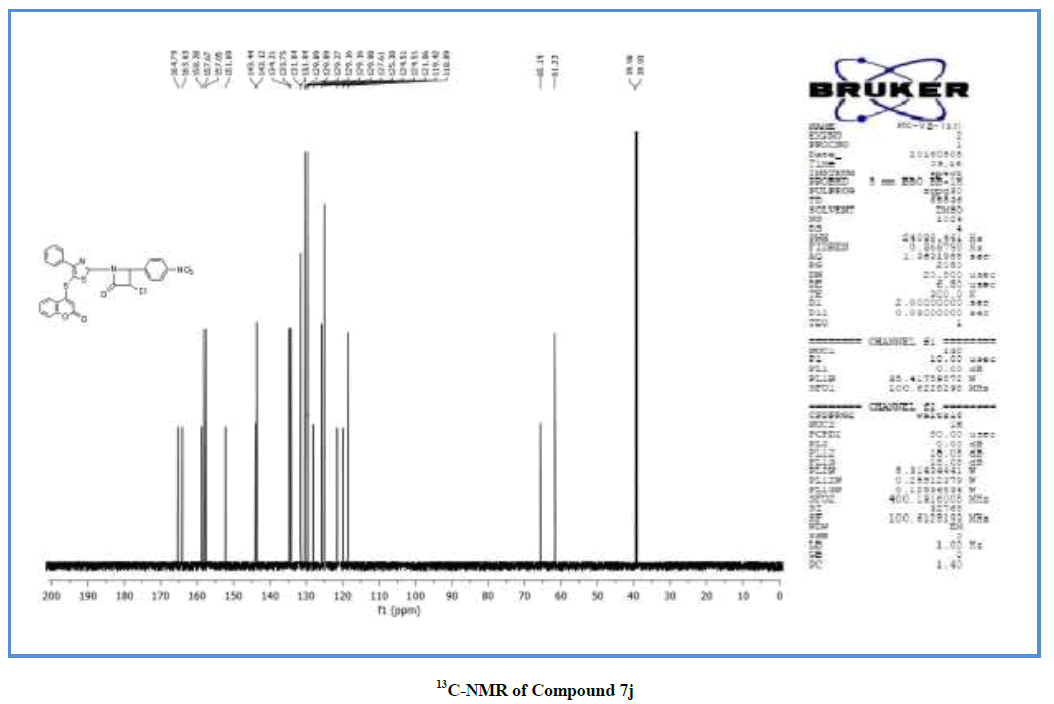
Results and Discussion
In vitro antibacterial activity
In this series, we have synthesized a series of compounds containing azetidinyl-thiazole fused motif with coumarin through sulphur bridge. Functionalization has been done on phenyl nucleus of azetidinone ring to develop different compounds. It has been twigged that the test compounds (7a-j) exhibited interesting antibacterial activity against bacterial strains such as Staphylococcus aureus, Escherichia coli, Pseudomonas aeruginosa, Streptococcus pyogenes (Table 2), however with a degree of variation. The chloro group containing final compounds i.e. 7b and 7d showed very good potency against specific bacterial strain. The final derivatives containing electron withdrawing nitro group i.e. 7h and 7j exhibited superior inhibition profile for the selected bacterial strains. On the other hand significant deviation of activity has been observed against Gram-negative strains where the unsubstituted phenyl ring containing azetidinone compounds i.e. 7a exhibited higher inhibition against the bacterial strain P. aeruginosa. Rest of the other compounds exhibited moderate to poor activity. Ciprofloxacin (MIC 5 μg/ml) and chloramphenicol (MIC 5 μg/ml) were used as standard control drugs for antibacterial activity.
| Compound | Minimal inhibitory concentration (µg/ml) | ||||
|---|---|---|---|---|---|
| -R | Escherichia coli | Pseudomonas aeruginosa | Staphylococcus aureus | Streptococcus pyogenes | |
| MTCC 442 | MTCC 441 | MTCC 96 | MTCC 443 | ||
| 7a | -H | 50 | 100 | 100 | 100 |
| 7b | 2-Cl | 25 | 50 | 100 | 62.5 |
| 7c | 3-Cl | 50 | 50 | 100 | 50 |
| 7d | 4-Cl | 50 | 62.5 | 125 | 50 |
| 7e | 2-CH3 | 200 | 250 | 500 | 500 |
| 7f | 3-CH3 | 100 | 62.5 | 500 | 500 |
| 7g | 4-CH3 | 125 | 200 | 250 | 100 |
| 7h | 2-NO2 | 100 | 25 | 100 | 50 |
| 7i | 3- NO2 | 62.5 | 50 | 100 | 50 |
| 7j | 4-NO2 | 100 | 62.5 | 62.5 | 50 |
| Ciprofloxacin | - | 25 | 25 | 50 | 5 |
| Chloramphenicol | - | 50 | 50 | 50 | 50 |
Table 2: In vitro antibacterial activity of newly synthesized compounds 7a-j
In vitro antifungal activity
All the newly synthesized compounds have been screened in vitro for their antimicrobial activity against fungal strains such as Aspergillus niger, Aspergillus clavatus and Candida albicans. Antifungal activity data (Table 3) revealed that the final compound 7a exhibited virtuous inhibition against the fungal strain A. clavatus. Furthermore, compounds 7b, 7c, 7i, and 7j showed good inhibition against C. albicans, A. niger and A. clavatus. Rest of the other compounds appeared with moderate to poor activity profile. Nystatin (MIC 5 μg/ml) and griseofulvin (MIC 5 μg/ml) were used as standard control drugs for antifungal activity.
| Compound | Minimal fungicidal concentration (µg/ml) | |||
|---|---|---|---|---|
| -R | Candida albicans | Aspergillus niger | Aspergillus clavatus | |
| MTCC 227 | MTCC 282 | MTCC 1323 | ||
| 7a | -H | 100 | 500 | 250 |
| 7b | 2-Cl | 250 | 250 | 500 |
| 7c | 3-Cl | 100 | 500 | 100 |
| 7d | 4-Cl | 500 | 100 | 250 |
| 7e | 2-CH3 | 1000 | >1000 | >1000 |
| 7f | 3-CH3 | 500 | 1000 | 1000 |
| 7g | 4-CH3 | 500 | 1000 | 1000 |
| 7h | 2-NO2 | 250 | 100 | 250 |
| 7i | 3- NO2 | 500 | 250 | 250 |
| 7j | 4-NO2 | 250 | 500 | 500 |
| Nystatin | - | 100 | 100 | 100 |
| Griseofulvin | - | 500 | 100 | 100 |
Table 3. In vitro antifungal activity of newly synthesized compounds 7a-j
Conclusion
The goal of our research work was the synthesis of new scaffolds without existing prior art. In conclusions we established an efficient synthesis of a series of some novel 3-chloro-1-(5-((2-oxo-2H-chromen-4-yl)thio)-4-phenyl thiazol-2-yl)-4-substituted phenyl azetidin-2-one. The structures of newly synthesized compounds were characterized by IR, 1H-NMR, 13C-NMR and mass spectral analysis and also were tested for their antibacterial activity against various bacterial strains such as E. coli, P. aeruginosa, S. aureus and S. pyogenes and their antifungal activity against various fungal strains such as C. albicans, A. niger and A. clavatus. The antimicrobial activities of the newly synthesized compounds 7a-j were evaluated and it was revealed that compounds are 7a, 7b, 7c, 7d, 7h, 7i and 7j potent antimicrobial agents against the tested microorganisms. Other analogues had moderate activity against different strains. It was possible to note that an aromatic ring lacking of chloro group on o, m & p positions are important for the antibacterial activity of these compounds. So, it can be considered potential lead molecules for further design and development of antimicrobial agents.
Acknowledgements
Authors are very thankful to Department of Chemistry, School of Sciences, Gujarat University, Ahmedabad, India for providing research facility. The authors wish to offer their deep gratitude to oxygen health care, Ahmedabad, India for carrying out spectral analysis.
References
- A.H. Abdel-Rahman, E.M. Keshk, M.A. Hanna, S.M. El-Bady, Bioorg. Med. Chem., 2004, 12(9), 2483-2488.
- A.A. Al-Amiery, R.I. Al-Bayati, K.Y. Saour, M.F. Radi, Res. Chem. Intermediat.,2012, 38(2), 559-569.
- R.V. Patel, P. Kumari, D.P. Rajani, K.H. Chikhalia, Med. Chem. Res., 2012, 21(12), 4177-4192.
- F. Belluti, G. Fontana, L. Dal Bo, N. Carenini, C. Giommarelli, F. Zunino, Bioorg. Med. Chem. Lett.,2010, 18(10), 3543-3550.
- A.B. Patel, K.H. Chikhalia, P. Kumari, J. Saud. Chem. Soc.,2014,18(5), 646-656.
- S. Jubie, B. Gowramma, N.K. Muthal, R. Kalirajan, S. Gomathi, K. Elango, Int. J. Chem. Tech. Res., 2009, 1(2), 153-157.
- D.H. More, N.S. Pawar, P.P. Mahulikar, JSIR., 2003, 62, 1024-1026.
- R.S. Keri, K.M. Hosamani, Monatsh. Chem., 2010, 141(8), 883-888.
- K. Vashi, H.B. Naik, J. Chem., 2004, 1(5), 272-275.
- K. Mogilaiah, R.B. Rao, K.N. Reddy, Indian J. Chem.,1999, 38B, 818-822.
- K.M. Thaker, V.V. Kachhadia, H.S. Joshi, Indian J. Chem.,2003, 42(b), 1544-1547.
- B.M. Mistry, S. Jauhari, Med. Chem. Res., 2013, 22(2), 635-646.
- R. Raj, C. Biot, S. Carrère‐Kremer, L. Kremer, Y. Guérardel, J. Gut, V. Kumar, Chem. Biol. Drug. De., 2014, 83(2), 191-197.
- S.L. Vasoya, M.R. Patel, S.V. Dobaria, H.S. Joshi, Indian J. Chem.,2005, 44B, 405-409.
- K.H. Patel, A.G. Mehta, E-J. Chem., 2006, 3(4), 267-273.
- N.B. Patel, M.D. Patel, Med. Chem. Res., 2017, 26, 1772-1783.
- S.B. Desai, P.B. Desai, K.R. Desai, Heterocycl. Commun., 2001, 7(1), 83-90.
- I. Banik, F.F. Becker, B.K. Banik, J. Med. Chem.,2003, 46(1), 12-15.
- K.S. Devi, M. Ramaiah, D.L. Roopa, V.P. Vaidya, E-J. Chem., 2010, 7(S1), S358-S362.
- T. Sperka, J. Pitlik, P. Bagossi, J. Tözsér, Bioorg. Med. Chem. Lett., 2005, 15(12), 3086-3090.
- H.N. Chopde, R. Pagadala, V.E. Jetti, J.S. Meshram, Int. J. Pharm. Biosci., 2011,2(1), 19-22.
- K.Z. Łączkowski, K. Misiura, A. Biernasiuk, A. Malm, A. Paneth, T. Plech, J. Heterocycl. Chem.,2015.
- B. Sadek, M.M. Tabakha, K.M.S. Fahelelbom, Molecules., 2011, 16(11), 9386-9396.
- T.A. Farghaly, M.A. Abdallah, M.A. Khedr, H.K. Mahmoud, J. Heterocycl. Commun., 2017.
- V. Jaishree, N. Ramdas, J. Sachin, B. Ramesh, J. Saud. Chem. Soc.,2012, 16(4), 371-376.
- P. Makam, P.K. Thakur, T. Kannan, Eur. J. Pharm. Sci., 2014, 52, 138-145.
- R. Mocelo-Castell, C. Villanueva-Novelo, D. Cáceres-Castillo, R.M. Carballo, R.F. Quijano-Quiñones, M. Quesadas-Rojas, G.J. Mena-Rejón, Open Chem., 2015, 13(1), 1127-1136.
- H.I. El-Subbagh, A.M. Al-Obaid, Eur. J. Med. Chem., 1996, 31(12), 1017-1021.
- B.S. Holla, K.V. Malini, B.S. Rao, B.K. Sarojini, N.S. Kumari, Eur. J. Med. Chem.,2003, 38(3), 313-318.
- O.I. El-Sabbagh, M.M. Baraka, S.M. Ibrahim, C. Pannecouque, G. Andrei, R. Snoeck, A.A. Rashad, Eur. J. Med. Chem.,2009, 44(9), 3746-3753.
- R.P. Karuvalam, K.R. Haridas, S.K. Nayak, T.N.G. Row, P. Rajeesh, R. Rishikesan, N.S. Kumari, Eur. J. Med. Chem.,2012, 49, 172-182.
- P. Karegoudar, M.S. Karthikeyan, D.J. Prasad, M. Mahalinga, B.S. Holla, N.S. Kumari, Eur. J. Med. Chem.,2008, 43(2), 261-267.
- A. Ayati, S. Emami, A. Asadipour, A. Shafiee, A. Foroumadi, Eur. J. Med. Chem.,2015, 97, 699-718.
- M. Basanagouda, K. Shivashankar, M.V. Kulkarni, V.P. Rasal, H. Patel, S.S. Mutha, A.A. Mohite, Eur. J. Med. Chem.,2010, 45(3), 1151-1157.
- O.O. Ajani, O.C. Nwinyi, J. Heterocycl. Chem.,2010, 47(1), 179-187.
- A. Kulkarni, S.A. Patil, P.S. Badami, Eur. J. Med. Chem., 2009, 44(7), 2904-2912.
- Y. Si, C.H. Zhou, Bioorg. Med. Chem. Lett., 2011, 21(3), 956-960.

